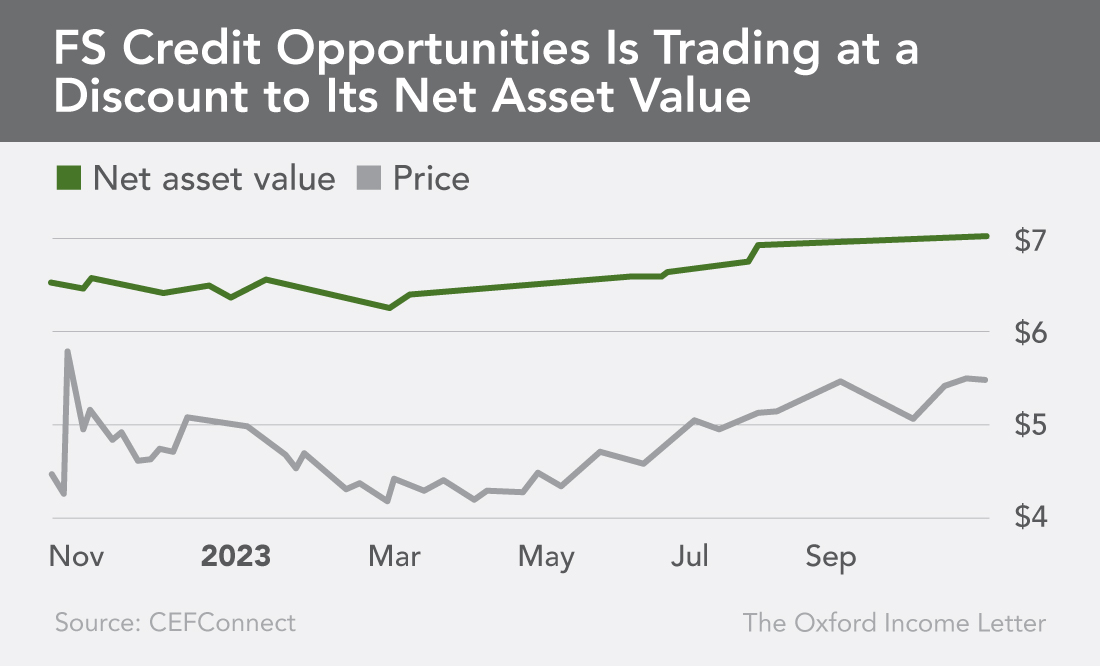You may want to consider and look into this one. It was recommended by my investment service in November/ 2023 and YTD up 27%, yield is 11%
FS Credit Opportunities (NYSE: FSCO) is one of the largest publicly traded credit-focused closed-end funds. The fund has $2.1 billion in assets, and it invests in bonds and loans to private companies.
From 2018 when the fund’s manager took over through the end of 2022, the fund outperformed high-yield bonds by nearly 2 percentage points per year.
The fund scours the credit markets to find unique opportunities to generate returns. It’s not buying the same bonds that every exchange-traded fund and mutual fund have in their portfolios.
The fund managers describe the fund’s strategy in the annual report:
We look for situations where return premiums exist due to complexity, illiquidity, or as a result of corporate events. Within the public markets, we look to invest in credits that are misunderstood and thus garner additional yield…
Safety FirstI like my bonds how I like my cars. Fast, but safe, with lots of airbags for when things go wrong.
These are high-yield bonds and loans, so they are not conservative. But the fund managers have done a great job in reducing the risk.
Senior secured bonds, which are backed by collateral, make up 77% of the portfolio. More than half of the portfolio is senior secured first lien debt, which means the holders of these bonds are first in line to get paid.
Additionally, industrywide, the current default rate for high-yield bonds is 2.71%, while the rate for loan defaults is 2.94%. Both of those figures are below the historical averages of 3.2% and 3.1%, respectively.
FS Credit Opportunities’ rate of nonaccruals (bonds and loans whose payments are late by 90 days or more) is just 2%, well below the industry average.
Furthermore, floating-rate instruments make up 58% of the portfolio. That keeps the duration low, which is important in a rising rate environment.
Duration is how a bond or portfolio is expected to perform based on a 1-percentage-point move in interest rates. The term used to describe this measurement is “years.” However, we’re not measuring time… we’re measuring percentages.
FS Credit Opportunities’ portfolio has a duration of just 0.92 years. So if rates rise another 1 percentage point, the NAV of the portfolio should decline just 0.92%. If rates fall, the portfolio should gain 0.92% for every 1-percentage-point decline.
A Screaming DiscountA mutual fund always trades at its NAV. If the NAV is $20 per share, the fund will trade at $20. If the next day the NAV rises to $20.50, so will the price of the fund.
Closed-end funds are different. The NAV certainly affects the price, but closed-end funds trade according to supply and demand, as stocks do. They will trade for whatever someone is willing to pay for them or sell them for.
As a result, closed-end funds trade either at a premium to the NAV (you’ll pay more than what the portfolio is worth) or at a discount (you’ll pay less).
I’m interested only in closed-end funds that trade at discounts – and whoa, Nelly, does this one trade at a discount.
The fund trades 20% below its NAV as I write. In other words, you are buying $1 in assets for $0.80. So we can make money two ways…
The first is if the discount shrinks.
The second way is if the NAV goes higher. Theoretically, the price of the fund should too.
As I write this, the fund’s NAV is $6.90 per share and it’s trading at $5.52, a 20% discount. If six months from now the NAV hasn’t budged but the discount has tightened to 10%, the price of the fund will be $6.21.
Of course, discounts can get larger too, but the 24% we’re seeing on FS Credit Opportunities is a very steep discount.
And we’re starting to see that discount shrink a bit. The discount was over 30% in March 2023 and 25% in July – so it’s moving in the right direction.
At the end of the third quarter, closed-end funds were trading at one of the steepest discounts in nearly 30 years. In fact, the discount has been greater only 5% of the time. That’s because many closed-end funds, including FS Credit Opportunities, use leverage. So when the stock market is weak, as it has been, or when rates are going higher, investors bail out.
However, if rates fall as I expect, the leverage should boost the fund’s return, attracting more buyers and shrinking the discount.
 View larger image View larger image
I also expect FS Credit Opportunities’ NAV to increase. An eventual decline in interest rates will help. But more importantly, only 4.5% of all high-yield bonds and loans mature in 2024. New bond issuances have been down sharply over the past two years, and demand is easily outpacing supply this year. Strong demand for bonds should push prices higher… taking the fund’s NAV along with them.
The DividendOn top of the fund being well valued, its yield is a whopping 12.4%. The $0.057 per share dividend was raised 15% in the second quarter and is paid monthly. And the fund’s net investment income covers the dividend.
It has been many years since I’ve recommended a bond fund. But one with a more than 12% yield, a 20% discount and strong prospects to see growth in its portfolio is a darn good place to do it again.
Action to Take: Buy FS Credit Opportunities (NYSE: FSCO) at the market, and add it to the Fixed Income Portfolio. Place a 25% trailing stop on your entry price. If possible, hold the fund in a tax-deferred account. |





 View larger image
View larger image